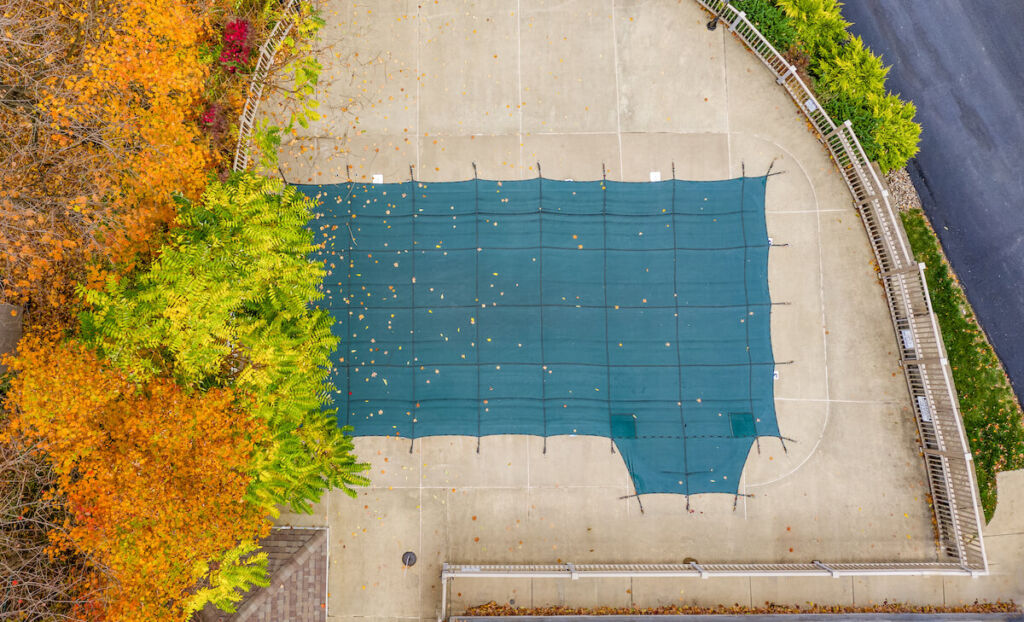Leaves are changing, temperatures are cooling, and, for certain climates, that means it’s the sad time of year to close your swimming pool.
As we reminisce on this year’s pool season and transition into the colder months, it’s time to winterize your pool so it will be prepped and ready for the next pool season. Closing your pool is a simple process that either you or your pool professional can do. If you plan on closing your own pool, make sure you follow these 10 pool closing steps to avoid expensive repairs in the spring.
How to Close Your Pool For Winter
Follow these steps to help guide you through closing your pool for the winter:
1. Start One Week Prior To Closing
We recommend starting to winterize your pool one week before you would like your pool to be completely closed. Timing is important to this first step, as closing your pool when water temperatures are higher could lead to algae growth. Professionals recommend waiting to winterize pools until the water temperature is consistently below 60 to 65 degrees. To begin the closing process, add a phosphate remover that can prevent any potential algae blooms.
2. Clean Your Pool Thoroughly
Make sure to clean your pool thoroughly by skimming all debris from the pool surface, emptying all skimmer baskets, vacuuming the floor and brushing the pool’s walls. Cleaning your pool before closing makes your spring pool opening even easier.
3. Balance Your Water Chemistry
This is one of the most important pool closing tips. Unbalanced pool chemistry can damage or destroy your pool surfaces and equipment. Use the following ranges to balance your pool water chemistry:
- pH: 7.2 – 7.4
- Alkalinity: 60 – 120 ppm
- Cyanuric Acid: 20 – 40 ppm
- Calcium Hardness: 200 – 400 ppm
4. Shock and Chlorinate Your Pool Water
It’s important to shock and chlorinate your pool water prior to closing your pool. Superchlorination is a good practice to make sure bacteria and algae don’t linger in unsuspecting areas of the pool vessel. Attempt to shock the pool at least two days before the last days of your pool closing. If that is not an option, shock the pool water the night before.
5. Apply an Algaecide to Your Pool Water
After shocking the pool water, apply an algaecide. The algaecide must be applied after shocking, do not apply both shock and algaecide at the same time.
6. Backwash Your Pool Filter
Backwashing your pool filter, also called backwashing your pool, is an important step to keeping your pool water clean. Over the life of your pool, the filter medium becomes clogged with dirt, oil and other debris as water passes through in one direction. To keep your filter effective, send water backward through the filter to force out any debris.
Take a look at these backwashing process tips from pool professionals.
7. Prepare Your Pool Equipment and Adjust the Water
If your pool is in a climate that experiences freezing temperatures, you can run the risk of damaged or burst pipes. To prevent costly repairs to your pool plumbing in the winter, follow these tips to prepare your pool equipment for the harsh cold weather:
- Adjust your water level four to six inches below the skimmer (vinyl-lined) or tile line (plaster).
- Drain pool lines and add antifreeze.
- Drain your filter, blow out the plumbing lines and remove all freeze plugs.
- Turn off all power breakers.
- Turn off all unused equipment to protect from snow and ice damage.
- If needed, remove unused hoses. Store hoses and Air Flow Meters in a safe, secure place.
If your pool is in an area that doesn’t have freezing temperatures in the winter, simply fill your pool water to a regular level and periodically check for evaporation. Also, remember to balance your pool chemistry at least once a month.
8. Install a Safety Cover
Installing a safety cover will protect your home and pool from potential accidents and winter debris. There are many different types of pool safety covers. To learn more about which type of pool safety cover is right for your pool, click here.
9. Lubricate the Essentials
One of the final steps to properly closing your pool for the winter is lubricating the essential pool equipment. Take some time to lubricate pump O-rings, backwash valve push-pull O-rings, and all threaded drain openings to prevent rusting. By lubricating these pieces now, you’ll ensure a secure, tight-sealing for next season’s pool opening.
10. Safely Store Accessories and Water Care Products
The last step in winterizing your pool is to store all pool accessories and water care products such as ladders, pool toys, robotic cleaners, skimmer baskets, wall fittings and solar blankets in a safe place. Additionally, we recommend separating and placing your water care products and chemicals in a well-ventilated, climate-controlled space.
Please remember, all pools are built differently, so consult your local pool professional for any questions about your specific pool equipment or climate in regards to proper storage.
Once you’ve successfully completed these steps, your pool will be ready for the winter months ahead. Since the most rewarding and relaxing pool seasons start with a proper pool closing, you’ll thank your future self for going through the proper winterizing precautions.
Have a spa to get you through the winter months? To learn how you can get the easiest, healthiest and best-feeling water with a Clear Comfort AOP spa sanitation system, click here.







